EAB has been detected in LaMoure County, North Dakota.
Current map of EAB in North Dakota
If you are concerned about your ash tree and suspect an infestation, please visit this page: Report a Suspect Ash Tree.
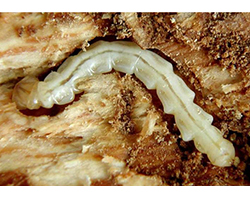 | 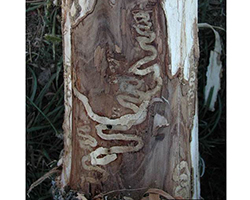 | 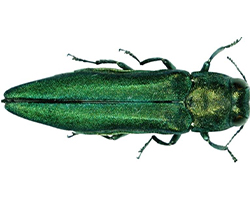 | 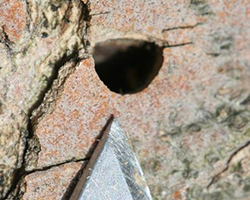 |
EAB Larvae* | EAB larval galleries* | Adult EAB** | EAB Exit Hole* |
*Photos by David Cappaert, Michigan State University
**Photo by Pennsylvania Department of Conservation and Natural Resources
Life Cycle and Identification
EAB adult females lay their eggs on the bark of the tree. Eggs are very small (less than 1mm) and rarely observed. Once hatched, the larvae tunnel their way into the tree where they feed beneath the bark creating serpentine galleries. Larvae are up to 1.25 inches long, creamy white and have several bell shaped segments. In the spring the EAB will pupate beneath the bark and emerge as an adult. The adult EAB will chew its way out of the tree creating D-shaped exit holes that are approximately 3-4mm in diameter. Adult EAB are 0.3-0.53 inches long with metallic green elytra (wing coverings).
Damage
While feeding beneath the bark of the tree the larvae disrupt the flow of nutrients throughout the tree. Once infested an ash tree can die in as little as 2 years. There are insecticide treatments available; however, they are costly, treat individual trees and most need to be repeated every year. Insecticide treatment is not recommended until EAB infestations are within 15 miles of your location (NDDA, NDFS, NDSU Extension position statement on insecticide use).
NDDA works with city foresters and ND Forest Service to place traps each year. However, new infestations are typically found by city foresters or tree removal companies while doing routine tree pruning and examining branches. Detection on a trap usually indicates a population well-established in an area.
For more information on EAB biology and management check out the NDSU Extension Publication “Emerald Ash Borer Biology and Integrated Pest Management in North Dakota”.
What you can do to prevent the introduction and spread of EAB:
Watch for signs and symptoms of EAB in your ash trees. If you suspect your ash trees could be infested with EAB, contact the North Dakota Department of Agriculture at 701-328-5110 or by email at ReportAPest@nd.gov.
Don't transport firewood into North Dakota and encourage your friends and relatives to refrain from bringing firewood into the state.
If you are concerned about your ash tree and suspect an infestation, please visit this page: Report a Suspect Ash Tree
Spreading the word:
Check out our EAB outreach toolkit for ideas.
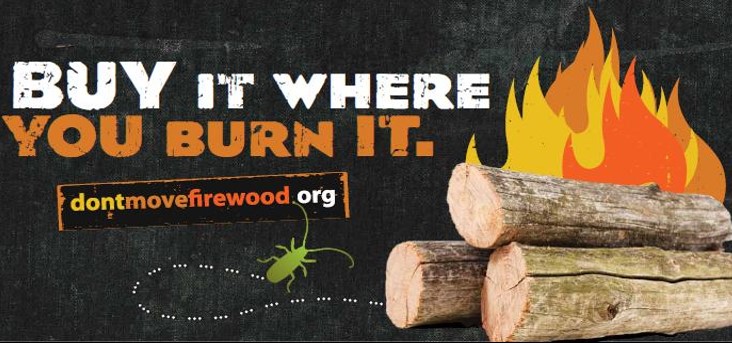
ADDITIONAL INFORMATION:
EAB Quarantine Information
Emerald Ash Borer Biology and Integrated Pest Management in North Dakota
Insects Frequently confused with EAB in ND
Ash Identification Guide
Signs and Symptoms of EAB
Insect galleries of EAB and other Ash Borers
Firewood Identification Guide
National EAB Information Website
Don't Move Firewood
Hungry Pests
South Dakota - EAB
Minnesota - EAB
USDA Infested EAB Counties Map

